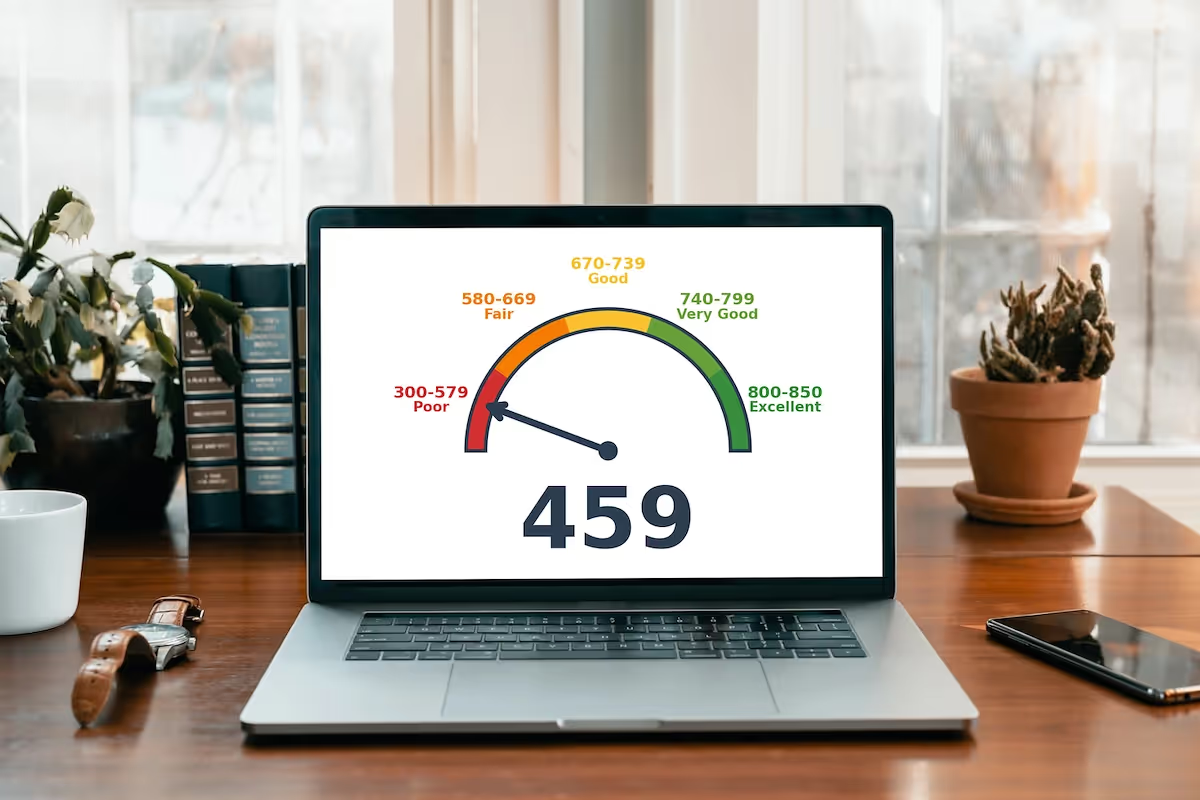
Kudos has partnered with CardRatings and Red Ventures for our coverage of credit card products. Kudos, CardRatings, and Red Ventures may receive a commission from card issuers. Kudos may receive commission from card issuers. Some of the card offers that appear on Kudos are from advertisers and may impact how and where card products appear on the site. Kudos tries to include as many card companies and offers as we are aware of, including offers from issuers that don't pay us, but we may not cover all card companies or all available card offers. You don't have to use our links, but we're grateful when you do!
459 Credit score: What You Need to Know in 2025
July 1, 2025


TL;DR
A 459 credit score provides a clear starting point for building a stronger financial future, placing you firmly in the 'Poor' FICO score category. While it signals a higher risk to lenders, it also represents a significant opportunity to improve your financial standing and unlock better terms down the road.
What Does a 459 Credit Score Mean?
A credit score of 459 places you in the "poor" credit range on the widely used FICO Score scale, which runs from 300 to 850. Lenders view scores below 580 as a sign of high risk, suggesting a history of significant financial difficulties. This could include issues like missed payments, accounts in collections, or other major credit problems.
Financially, a 459 score creates major hurdles. You'll likely find it very difficult to get approved for new credit cards, auto loans, or mortgages. Any credit you are offered will probably come with steep interest rates and strict terms, making borrowing much more expensive. While this situation is challenging, it's important to view it not as a final verdict, but as a baseline from which improvement is possible.
Who Has a 459 Credit Score?
While a 459 credit score is significantly below average for any demographic, credit scores generally improve over time. Here is a breakdown of the average FICO scores by generation, based on 2023 data from Experian:
- Generation Z (ages 18-26): 680
- Millennials (ages 27-42): 690
- Generation X (ages 43-58): 709
- Baby Boomers (ages 59-77): 745
- Silent Generation (ages 78+): 760
Credit Cards With a 459 Credit Score
A credit score of 459 falls into the "very poor" range, which can significantly hinder your ability to get approved for a traditional credit card. Lenders view this score as an indicator of high risk, making them hesitant to extend credit due to concerns about potential defaults. Consequently, your options will likely be restricted to secured credit cards or specific subprime unsecured cards that often come with higher fees and interest rates.
Fintech company Kudos offers AI-powered tools that can simplify your search by providing personalized recommendations based on your financial goals and spending habits. Features like Dream Wallet even offer insights into how a new card could affect your credit score, ensuring you find a match that fits your unique situation.
Auto Loans and a 459 Credit Score
Securing an auto loan with a 459 credit score is challenging but not impossible, placing you in what lenders call the deep subprime category. While you may still get approved for a loan, you can expect to face significantly higher interest rates and less favorable terms.
According to a 2025 guide on auto loan rates, here are the average interest rates broken down by credit score bracket:
- Super-prime (781-850): 5.25% for new cars, 7.13% for used cars
- Prime (661-780): 6.87% for new cars, 9.36% for used cars
- Non-prime (601-660): 9.83% for new cars, 13.92% for used cars
- Subprime (501-600): 13.18% for new cars, 18.86% for used cars
- Deep subprime (300-500): 15.77% for new cars, 21.55% for used cars
Mortgages at a 459 Credit Score
Unfortunately, a 459 credit score makes qualifying for a traditional mortgage nearly impossible. Most mortgage requirements for government-backed loans, like FHA, start at a 500 credit score with a 10% down payment. While some alternative financing options like owner financing or rent-to-own may exist, they are less common and carry considerable risks that require careful consideration.
Even if you find a specialty lender, a low credit score will severely impact your loan terms. Lenders associate low scores with high risk, which translates to significantly higher interest rates, larger fees, and a substantial down payment requirement. This makes any potential loan much more expensive over its lifetime and limits how much you can borrow.
What's in a Credit Score?
Figuring out what goes into your credit score can feel like trying to solve a complex puzzle, but it generally boils down to a handful of key elements. The most common factors include:
- Your history of making payments on time is the most significant factor.
- How much of your available credit you're currently using, known as your credit utilization ratio, plays a major role.
- The age of your credit accounts, including the average age and the age of your oldest account, is also considered.
- Lenders like to see that you can responsibly manage different types of credit, such as credit cards and loans.
- Opening several new credit accounts in a short period can be seen as a risk and may temporarily lower your score.
How to Improve Your 459 Credit Score
While a 459 credit score falls into the poor range, it is absolutely possible to improve it with the right strategy and consistent effort. According to a guide from Kudos, most people can see meaningful changes within three to six months of adopting positive financial habits.
- Establish Automatic Bill Payments. Since payment history is the single most significant factor in your credit score, setting up automatic payments is a crucial first step. For a score of 459, creating a perfect record of on-time payments will build the strongest foundation for improvement.
- Reduce Your Credit Utilization Ratio. This ratio, which is the amount of credit you're using compared to your total limits, is the second most important scoring factor. Paying down balances to get this ratio well below 30% can provide one of the quickest boosts to a low credit score.
- Monitor Your Credit Reports. Regularly reviewing your credit reports from all three bureaus allows you to spot and dispute inaccuracies that could be unfairly damaging your score. Correcting even a single error can have a significant positive impact when you're working to rebuild your credit.
- Become an Authorized User or Get a Secured Card. Being added as an authorized user on an account with a long, positive history can add that good data to your own credit file. Alternatively, a secured credit card allows you to build your own positive payment history, which is essential for demonstrating creditworthiness when your score is low.
The free Kudos browser extension can help you manage your cards and maximize rewards as you work to improve your financial health.
Unlock your extra benefits when you become a Kudos member

Turn your online shopping into even more rewards

Join over 400,000 members simplifying their finances

Editorial Disclosure: Opinions expressed here are those of Kudos alone, not those of any bank, credit card issuer, hotel, airline, or other entity. This content has not been reviewed, approved or otherwise endorsed by any of the entities included within the post.



































.webp)



.webp)



.webp)

